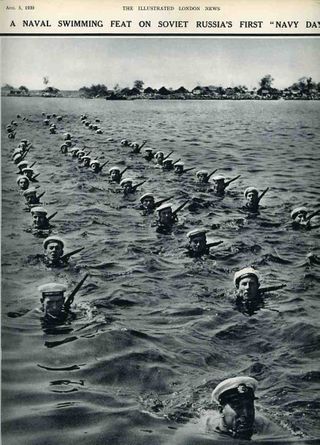JF Ptak Science Books LLC Post 395
This image of swimming Soviet sailors of the Baltic Fleet is from The Illustrated London News for August, 1939. The sailors were "celebrating" the first Navy Day for the Soviet Navy, and no other way was better to do this than to swim 400 meters in formation and fully clothes--with rifles on their backs with no water protection whatsoever. Perhaps this group was just standing in 5 feet of water near the shore--I suspect not, though, because a bunch of these guys look as though they're really struggling. We're about a month away from the German invasion of Poland and the official start to the bigger part of the war that went global: Czechoslovakia and China had already experienced war for some time now.
 On November 30 the Soviets would launch their own hideous offensive, though against Finland: the Winter War would bring international condemnation of the Soviet Union and give their new ally in Nazi Germany considerable pause. The Red Army was decimated by the wicked Stalinist purges of the late 1930's--as much as 50% of the senior military cadre were disappeared and executed--and the army as a whole suffered. The early result of this action was that the Finns, though vastly out-manned and out-teched (the Soviet forces had four times as many soldiers as the Finns, 30 times as many aircraft and 200 times as many tanks), were able to last against the Red war machine until March. An end to hostilities agreement was reached in which Finland maintain its sovereignty and gave away 20% of its industrial base and 9% of its territory. The Soviets achieved a phyrric victory, the Finns achieved a major success, and the Nazis figured out that perhaps rather than keep the Soviets as a weak ally they might be able to make them into a dead -state enemy (turning against them with Operation Barbarossa).
On November 30 the Soviets would launch their own hideous offensive, though against Finland: the Winter War would bring international condemnation of the Soviet Union and give their new ally in Nazi Germany considerable pause. The Red Army was decimated by the wicked Stalinist purges of the late 1930's--as much as 50% of the senior military cadre were disappeared and executed--and the army as a whole suffered. The early result of this action was that the Finns, though vastly out-manned and out-teched (the Soviet forces had four times as many soldiers as the Finns, 30 times as many aircraft and 200 times as many tanks), were able to last against the Red war machine until March. An end to hostilities agreement was reached in which Finland maintain its sovereignty and gave away 20% of its industrial base and 9% of its territory. The Soviets achieved a phyrric victory, the Finns achieved a major success, and the Nazis figured out that perhaps rather than keep the Soviets as a weak ally they might be able to make them into a dead -state enemy (turning against them with Operation Barbarossa).
In any event by 1945 my suspicion is that most of these men would be dead.
Most of the Great Patriotic War of the Soviet Union would take place on land, with Russian military war dead amounting to a staggering 65% of all Allied deaths, with something like 13 to 15 % of the entire population (totaling 168 million) of the Soviet Union being killed during the conflict. The Soviet sailors would've had a better chance of survival, but not by much.
Some Statistics:
The composition of the Soviet fleets in 1941 included:
3 line battleships
7 cruisers (including 4 modern Kirov-class cruisers)
59 destroyer-leaders and squadron-destroyers (including 46 modern Type 7 destroyers and Type 7U destroyers)
218 submarines
269 torpedo boats
22 patrol vessels
88 minesweepers
Military Losses (1939-1945): Vessels
Germany 672
Japan 433
Italy 300
U.S. 157
Britain 296
France 129
Soviet Union 102
U.S. Navy Ship Losses during WWII according to Navy Department, October 5, 1945 http://www.usmm.org/navylossww2.html
Battleships 2
Aircraft carriers 11
Heavy cruisers 7
Light cruisers 3
Destroyers 71
Destroyer escorts 11
Submarines 52
Minelayers 3
Minesweepers 24
Submarine chasers 18
Gunboats 12
Coast Guard vessels 15
Seaplane tenders 3
Motor torpedo boats 69
Tank landing ships 40
Medium landing ships 9
Tank landing craft 67
Infantry landing craft 22
Support landing craft 6
Tugs 10
Tankers 6
Troop transports 21
District patrol craft 36
Misc. district craft 152
Cargo vessels 4
Misc. auxiliaries 22
Source: The Sea and the States - A Maritime History of the American People, Samuel W. Bryant, New York: Thomas Y. Crowell Company, 1947, p. 569 http://www.usmm.org/navylossww2.html




Comments